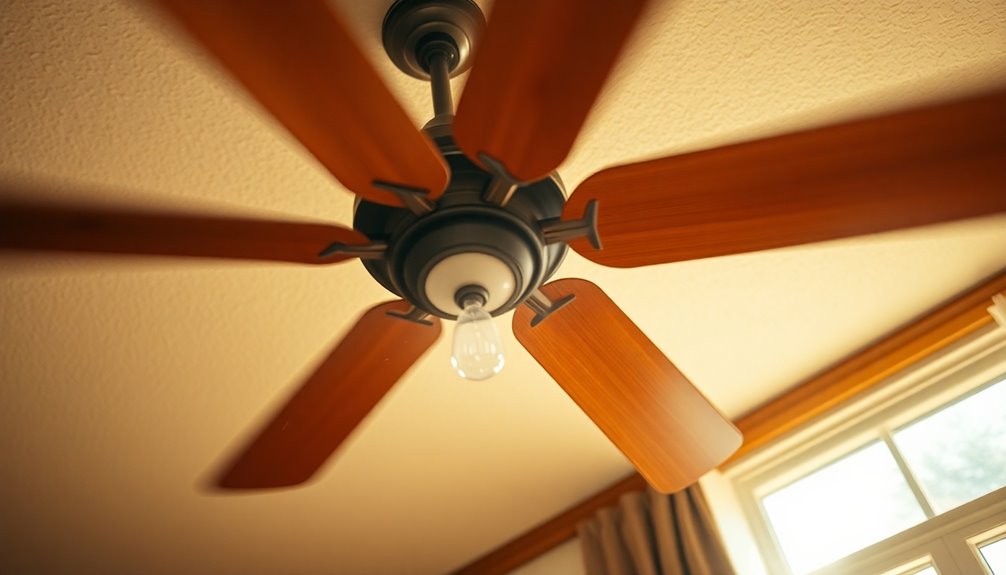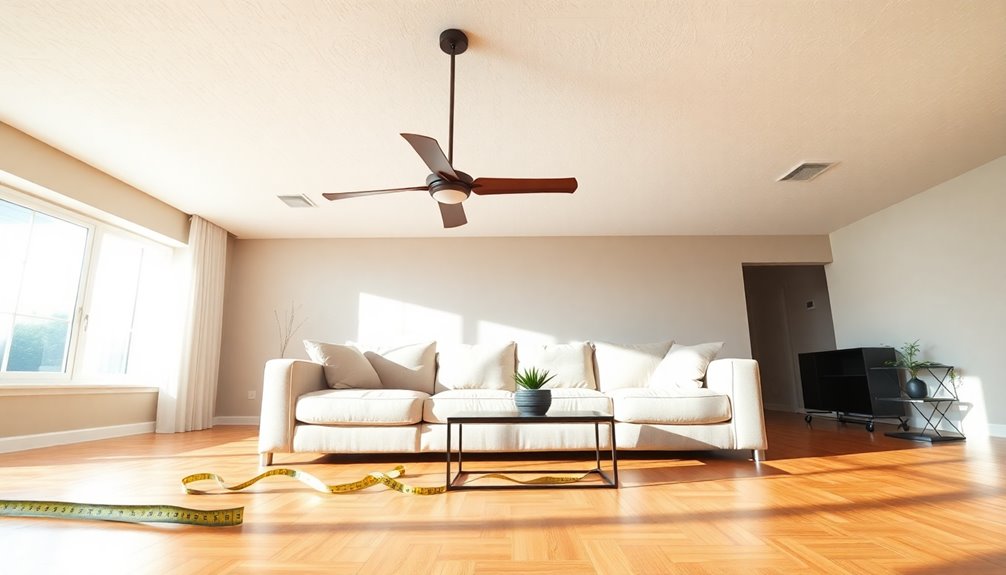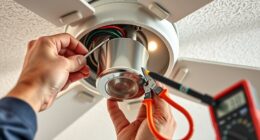A ceiling fan wobbles primarily due to uneven blade lengths, loose screws, or dust accumulation that disrupts its balance. If the blades are misaligned or warped from humidity, this can add to the instability. Regular maintenance, like cleaning and tightening screws, can help prevent these issues. You might also find that using a blade balancing kit can solve persistent wobbling by including weights to even out the blades. By paying attention to these factors, you can guarantee your fan operates smoothly. Curious about how to fix your wobbling fan? Stay tuned for more tips and solutions.
Key Takeaways
- Uneven blade lengths disrupt the balance of the ceiling fan, causing wobbling during operation.
- Loose screws can lead to shifting blades, resulting in instability and wobbling.
- Dust and dirt accumulation creates uneven weight distribution, affecting fan performance.
- Warped blades from humidity or temperature changes can exacerbate wobbling issues.
- Improper installation can create instability, leading to a wobbling ceiling fan.
Causes of Ceiling Fan Wobbling

Ceiling fan wobbling can be frustrating, and understanding its causes is essential for effective resolution. One common reason for ceiling fan wobbling is uneven blade lengths. If the blades aren't the same size or shape, it can disrupt the fan's balance.
Loose screws can also play a significant role, as they may allow the blades to shift during operation. Dust and dirt accumulation on the blades can lead to uneven weight distribution, causing one side to sag and creating wobbling during high-speed use.
Additionally, warped blades, often caused by humidity or temperature changes, can exacerbate these issues by altering the blades' shape and balance. Improper installation, such as using a non-fan rated ceiling box or an insecure mounting bracket, can result in instability, leading to wobbling when the fan is in motion.
Finally, normal wear and tear, including loose hardware and motor problems, can develop over time, contributing to an increase in wobbling incidents. By identifying these causes, you can take the necessary steps to restore balance and functionality to your ceiling fan.
Fixing Blade Alignment

Addressing the causes of ceiling fan wobbling often leads to the importance of fixing blade alignment. Start by guaranteeing all fan blades are tightly secured to their respective blade holders; loose screws can greatly contribute to a wobbly ceiling fan.
Check the screws that hold the blade holder to the fan flywheel for tightness, as any looseness here can disrupt blade alignment.
Next, you'll want to measure the distance from the blades to the ceiling using a yardstick. This guarantees uniformity among all blades, which is essential for proper balancing.
If you find that some blades are misaligned, gently bend the blade holder to adjust the angle and position, helping to level the fan blades.
Once you've made these adjustments, it's time to run the fan and test for wobbling. If it continues to wobble, you may need to revisit your adjustments for further alignment or balancing.
Using a Blade Balancing Kit

To effectively tackle ceiling fan wobbling, using a blade balancing kit can be a game changer. This kit typically includes plastic clips and adhesive weights designed to help you correct the weight distribution of your ceiling fan blades.
Start by attaching a plastic clip to the end of a suspected wobbly blade and run the fan. This helps you identify which blade causes the wobble.
Once you pinpoint the offending blade, reposition the clip along the blade to find the most efficient location for minimizing wobbling. After identifying the ideal position, replace the clip with an adhesive weight for a more permanent solution to balance the blade.
It's essential to repeat this testing process for all blades until the wobbling is resolved. If your fan continues to wobble, you may need to adjust the weights or check other factors.
Using a blade balancing kit not only helps secure a smooth operation for your ceiling fan but also prevents future issues. Remember, implementing this technique can greatly enhance your fan's performance and longevity, ensuring your environment remains comfortable and peaceful.
Importance of Regular Maintenance

Maintaining your ceiling fan goes beyond just using a blade balancing kit. Regular maintenance is vital for preventing wobbling and ensuring your fan runs efficiently throughout its lifespan. By keeping up with cleaning and inspections, you can tackle issues before they escalate.
Here are three essential aspects of regular maintenance:
- Cleaning: Dust accumulation on fan blades can disrupt balance and lead to wobbling. Regularly wiping down the blades keeps them stable.
- Tightening Loose Hardware: Inspect the fan for any loose screws or hardware. Securely attached components help avoid wobbling and potential damage.
- Periodic Inspections: Check for misaligned blades or other issues that could affect performance. Early detection can prolong the life of your fan motor.
Implementing a maintenance schedule—like checking your fan at least once a year—ensures both safety and efficiency.
Addressing minor wobbling issues promptly not only extends the lifespan of your ceiling fan but also reduces energy consumption. By staying proactive with maintenance, you can enjoy a stable, efficient ceiling fan for years to come.
Common Mistakes to Avoid

Wobbling ceiling fans can often be traced back to common mistakes during maintenance and inspection. One major oversight is ignoring blade warping or misalignment; even minor discrepancies can disrupt the balance of a ceiling fan, leading to a wobbly experience.
Rushing through the inspection process means you might overlook critical issues like loose screws or an improperly secured mounting bracket. These loose components can drastically destabilize your fan, resulting in increased wobbling.
Don't focus solely on the fan body while neglecting the ceiling box, as underlying problems in that area can affect stability and performance. Always remember to tighten the screws on both the blades and the mounting bracket; a loose bracket can exacerbate wobbling issues.
Additionally, if you encounter complex problems that seem beyond your expertise, don't hesitate to seek professional help. Trying to fix intricate motor or internal component issues on your own can worsen the situation.
When to Seek Professional Help

Sometimes, a ceiling fan's persistent wobble signals that it's time to call in the professionals. If you've already tried cleaning and adjusting the fan with no success, you may be facing deeper issues. A wobbly ceiling fan could indicate warped blades or potential motor problems that require replacement parts or repairs by a qualified technician.
Here are some key signs that you should seek professional help:
- Unusual Noise: If your fan makes strange sounds while wobbling, this could suggest mechanical failures, needing immediate attention.
- Ineffective Balancing: If using a balancing kit doesn't fix the persistent wobbling, it's time for a professional evaluation.
- Improper Installation: If your fan is in a non-fan rated ceiling box and feels unstable, you'll want to enlist professional installation services for safety and stability.
Don't hesitate to reach out to customer service for guidance on finding the right expert.
Addressing these issues promptly not only guarantees your ceiling fan operates safely but also prolongs its lifespan, preventing further complications down the line.
Frequently Asked Questions
How Do I Stop My Ceiling Fan From Wobbling?
To stop your ceiling fan from wobbling, first, check that all screws and hardware are tight.
Clean the blades regularly to remove dust, which can cause imbalances.
Use a blade balancing kit to adjust weights and identify any persistent issues.
Inspect the blades for warping, and confirm your fan is mounted on a ceiling box that's rated for fan support.
Following these steps should help you achieve a steady, wobble-free fan.
Will a Ceiling Fan Fall if It Wobbles?
Did you know that nearly 2,000 injuries each year in the U.S. are linked to falling ceiling fans?
If your ceiling fan wobbles considerably, it's vital to address the issue immediately. While minor wobbling mightn't cause immediate danger, excessive wobbling can lead to detachment from its mounting bracket.
It's best to check for loose screws and guarantee proper installation to avoid potential accidents. If it persists, don't hesitate to call a professional for help.
How to Know if a Ceiling Fan Will Fall?
To know if your ceiling fan will fall, check for any wobbling or shaking when it's on.
Inspect the mounting bracket and screws for tightness, as loose connections can indicate instability.
Look for gaps between the fan canopy and the ceiling, which might suggest a poor installation.
If you notice a non-fan-rated ceiling box, that could also increase the risk.
Regular maintenance can help guarantee your fan stays secure and safe.
What Does It Mean When a Fan Wobbles?
When your fan wobbles, it usually means there's an imbalance somewhere. You might've misaligned blades or uneven weight distribution among them.
Dust buildup on one side can also add extra weight. Check for loose screws holding the blades or mounting bracket; they might need tightening.
Changes in humidity or temperature could've warped the blades too. If it keeps wobbling, it might be time to call a professional to inspect it.
Conclusion
To sum up, addressing a wobbling ceiling fan not only enhances your comfort but also prolongs the fan's lifespan. For example, imagine Sarah, who ignored her fan's wobble until it eventually broke down, costing her more in repairs than if she'd fixed it early on. By keeping an eye on blade alignment and performing regular maintenance, you can avoid this hassle. So, take action now, and enjoy a smooth, quiet ceiling fan for years to come!









